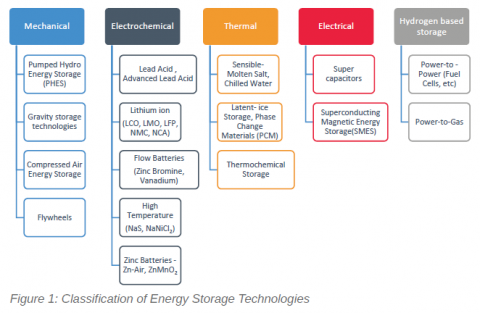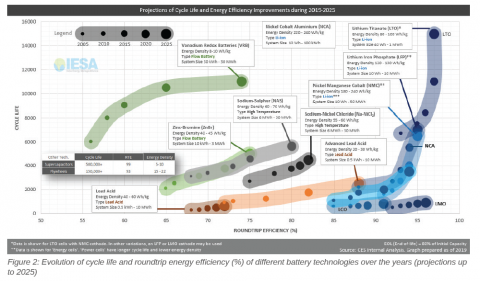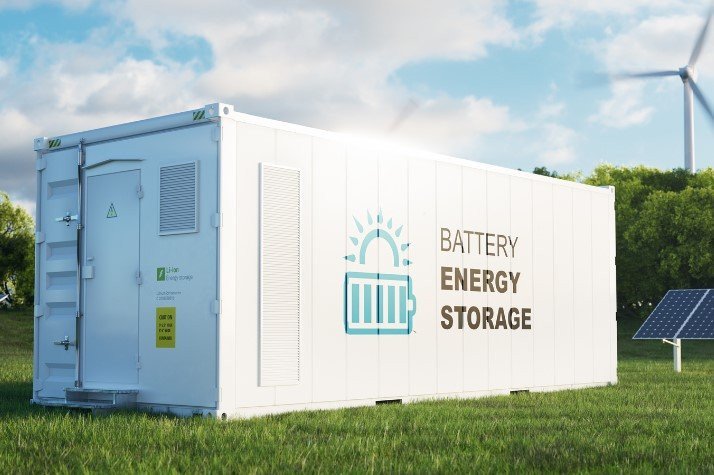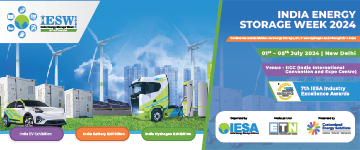Classification of energy storage technologies: an overview
Energy storage helps capture generated energy and deliver effectively for future use, but this can be done in more than one way. This article encapsulates the various methods used for storing energy.
Energy storage technologies encompass a variety of systems, which can be classified into five broad categories, these are: mechanical, electrochemical (or batteries), thermal, electrical, and hydrogen storage technologies.
Advanced energy storage technologies are capable of dispatching electricity within milliseconds or seconds and can provide power back-up ranging from a few minutes to many hours. The suitable duration (long or short) of storage, scale of systems (in MW and MWh) and response time are technology dependent making it important to choose the appropriate technology as per the application requirements and constraints.
Mechanical Storage
These technologies store energy in the form of gravitational potential energy, kinetic energy (of motion), or potential energy of compression. It includes Pumped Hydro Storage (PHS), Gravity Energy Storage, Compressed Air Energy Storage (CAES) and Flywheels storage technologies.
Pumped Hydro Storage (PHS)
In these systems, the energy is stored as the potential energy of water kept on a higher elevation. Generally, this involves pumping water into a large reservoir at a high elevation—usually located on the top of a mountain or hill. When energy is required, the water in the reservoir is guided through a hydroelectric turbine, which converts the energy of flowing water to electricity. PHS is often used to store energy for long durations (8-24 hours).
Gravity Storage Technologies
Gravity based energy storage technologies use the same principle as PHS systems. However, the important difference is that cement or bricks, or rocks are used as
the mass moving up or down
instead of water. The important advantage of this is that the size of the systems is much smaller due
to the higher density of these
solids compared to water. Additionally, the requirement
of specific geological features can be avoided.
Compressed Air Energy Storage (CAES)
A CAES system uses excess electrical energy to compress air using an electrically driven pump, which is stored either in an underground cave or above ground in high-pressure containers.
When excess or low-cost electricity is available from the grid, it is used to run an electric compressor, which compresses air and stores it under high pressure. When electrical energy is required, the compressed air is directed towards a modified gas turbine, which converts the stored energy to electricity.
Flywheel Energy Storage (FES)
Flywheels store electrical energy as rotational energy in a heavy cylindrical rotating mass. Flywheel energy storage systems typically consist of a large rotating cylinder supported on a stator.
Stored electric energy increases with the square of the speed of the rotating mass, so materials that can withstand high velocities and centrifugal forces are essential for its construction. In general, flywheels are very suitable for high power applications due to their capacity to absorb and release energy in a very short duration of time.
Electrochemical Storage
Electrochemical storage technologies include various battery technologies that use different electrochemical reactions to store electricity namely lead-acid batteries, lithium-ion (Li-ion) batteries, sodium-sulfur batteries (NAS), flow batteries, Zn-air batteries, and supercapacitors. The batteries, depending on type, may be suitable for a short duration (few minutes) or long duration (8+ hours) applications. For stationary storage applications, two of the main parameters are the cycle life and the roundtrip energy efficiency (%) of the batteries. The graph below shows the evolution of these two parameters for various battery technologies over the years along with projections up to 2025.
Thermal Storage
The principle of storage of energy in thermal energy storage systems is conceptually different from electrochemical or mechanical energy storage systems. Here, the energy by heating or cooling down appropriate materials using excess electrical energy. When required, the reverse process is used to recover the energy. This category of technologies includes ice-based storage systems, hot and chilled water storage, molten salt storage and rock storage technologies.
Sensible Heat Storage
Available energy is stored in the form of an increase or decrease in temperature of a material, which can be used to meet a heating or cooling demand. One of the most well-known technologies of this type is molten salt storage. This type of storage is generally coupled with Concentrated Solar Power (CSP) plants where the heat generated is used to increase the temperature of molten salt. Another important technology in this space is hot and chilled water storage. These are especially relevant where a large part of the electrical load is for space heating or cooling applications.
Latent Heat Storage
In these systems, the energy is stored in a material that undergoes a phase change (transition between solid and liquid) as it stores and releases energy. Examples include ice storage tanks for domestic or industrial cooling applications. During periods of excess energy and low demand (usually night-time), the liquid water is converted into ice and stored in large tanks. When the cooling load increases during the daytime and afternoon, the ice is melted to provide space cooling to the connected buildings. Two companies active in this space are Calmac and Ice Bear Energy Systems. Another type of technology in this category is phase change materials (PCMs). PCMs are specific material compositions that melt at a particular temperature of interest.
Thermochemical Storage
The third category of thermal storage involves storing energy in reversible chemical reactions. Compared to the other two technologies these are much more compact and lightweight. There are multiple variations of this technology most of which are currently in the initial prototype development stage.
Electrical Storage
Super capacitors and Superconducting Magnetic Energy Storage (SMES) systems store electricity in electric and electromagnetic fields with minimal loss of energy. A few small SMES systems have become commercially available, mainly used for power quality control in manufacturing plants such as microchip fabrication facilities. These technologies are ideal for storing and release high levels of energy over short bursts due to their lower price in $/kW (power).
Hydrogen Storage Technologies (Power-to-Gas)
The basic concept of hydrogen storage technologies is to use electricity to perform electrolysis of water to produce hydrogen and oxygen. The hydrogen produced is stored in high pressure containers and can be used as a fuel for direct combustion (cooking and heating applications) or for electricity generation via PEM Fuel Cells.

























